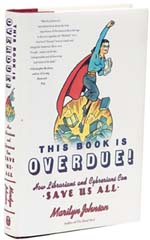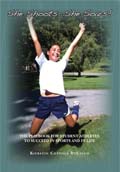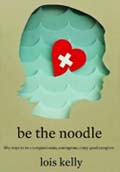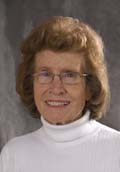|
Previews
|
|

|
Keepers of the Key
Librarians have the answers,
Marilyn Johnson '78G discovered
This Book is Overdue! How Librarians
and Cybrarians Can Save Us All
HarperCollins, 2010
See also In Their Own Words
by Anne Downey '95G

Perry Smith/UNH
Photographic Services
|
In 2005, Marilyn Johnson '78G was researching her first book when a reference librarian showed her how to save web pages to her computer. "To someone who already knew how to do it, it was idiotically simple," she writes in her new book, "but for me ... it was a revelation."
Johnson says she didn't want to leave the library. "I thought, 'If you know how to do this, and you're willing to help me, for free, and you won't laugh at me, what else do you know?'" And that was the genesis of her wonderful new book, This Book is Overdue! How Librarians and Cybrarians Can Save Us All (HarperCollins, 2010).
Johnson knew from writing her first book, The Dead Beat, that librarians often have the quirkiest obituaries; she was looking forward to finding out more about them. It promised to be a pleasant and civilized project.
But in the first six months of her research, she watched her local library consortium go through a chaotic cataloging-software migration. She interviewed the Connecticut Four—three librarians and their director—who refused to comply with an FBI demand to hand over their computer records; they challenged the Patriot Act, sued the federal government and fought for their patrons' right to privacy. And she created an avatar named Marilena Basevi and spent months learning how to navigate the virtualreality site Second Life so that she could crash librarian parties and eavesdrop on librarian-avatars' conversations.

It was a fast-paced, sometimes frantic, couple of years. "The profession that had once been the quiet gatekeeper to discreet palaces of knowledge is now wrestling a raucous, multiheaded, madly multiplying beast of exploding information and information delivery systems," she writes. She joined the fray, and her account is energetic, informative and timely.
If libraries and librarians were slow to embrace the digital age, they clearly have caught up, and many are now on the frontlines. Johnson writes about librarians who are doing cyber-missionary work, teaching computer skills to students from emerging countries. She follows Radical Reference, an activist group of librarians who took to the streets during the 2008 Republican Convention to provide reference support to demonstrators, "armed with iPhones bookmarked to a wiki loaded with information about political candidates and schedules, the Twin Cities, public toilets, fast food, and legal aid." And she writes about cybrarian blogs—cybrarians being "the new breed of tech-savvy librarians, part cyborg, part cat's-eye reading glasses."
Johnson didn't intend to become an advocate for public libraries and librarians, but that's what her book has become. While most authors tour for a couple of months, Johnson is booked for speaking engagements into 2012. And she has started an American Library Association affinity group, Authors for Librarians.
"Practically all the major cities in America are cutting their library budgets, and shutting branches, just when we need their services more than ever," she says. "Public librarians have no commercial interest. They're interested in open access, and they want to help. And it's unbelievable how they can bend a computer to find information. We don't want this workforce to be wasted."
|
Overviews:

Freshwater Fish of the Northeast
illustrated by Matt Patterson '03, text by David A. Patterson
University Press of New England, 2010
See at amazon.com
"Some people spend a lifetime trying to catch just one [blueback trout]," the reader learns in this lovely book by a father and son team, which is a manual, a folkloric history and an art book all in one, and features gorgeous illustrations of more than 60 species.

Speeding Softly
The Dejas
37' Productions, 2010
See at thedejas.com
The debut release by Callie Lipton '06 and Aaron Katz is a pleasing collection of songs anchored by Lipton's husky, hypnotic vocals and Katz's lush arrangements.

Forest Forensics: A Field Guide to Reading the Forested Landscape
by Tom Wessels '73, The Countryman Press, 2010
See at amazon.com
This useful guide shows you how observable evidence within a forest--the shape of trees, decay patterns in stumps, the presence of stone walls--can be used to figure out its history.
Also see:
In Their Own Words: Descriptions of new and recent written work by the authors themselves Kierstin Coppola DeCicco '91
Lois Kelly '77
Michael Martinelli '99
Jean (Wade) Foley Doyle '72G
|
   
In Their Own Words
Descriptions of new and recent written work by the authors themselves
Kierstin Coppola DeCicco '91
See at amazon.com
She Shoots...She Soars!
It will be twenty years this May since my husband-to-be and I left the UNH Wildcat playing fields for the last time. Some regrets here and there, like when my lacrosse team lost to Maryland in the NCAA Final Four Tournament in sudden death overtime, in May of '91. But for the most part, these were four, fabulous, life-changing years for us both!
As a student athlete I learned how to juggle more than soccer balls. UNH taught me how to build confidence in myself, how to set high goals and how to achieve them. Marge Anderson, my soccer and lacrosse coach, played a huge role in teaching all of us how and why to believe in ourselves. We were blessed to have her leadership.
She Shoots...She Soars! is a direct product of my time at UNH. In writing it, I, of course, wanted high school athletes to understand how great it is to play in college. But I also want them to understand that playing at the college level involves so much more than that. In my athletic career at UNH, I found each passing quarter to be more and more about self-esteem, confidence and, ultimately, about being truly happy inside.
I look forward to meeting any young, aspiring student athletes that you know out there, via my website, www.sheshootsshesoars.com. My next playbook will be a collection of stories from girls who have found new success within themselves, on or off the playing fields.
|
 |
|
Lois Kelly '77
See at amazon.com
Be the Noodle: 50 Ways to Be a Compassionate, Courageous, Crazy-Good Caregiver
When I went to UNH in the 1970s, my friends and I thought we could do anything - the world was wide open with possibilities, which over the years we've all leapt into over and over again. But when my mother was diagnosed with terminal cancer and asked me to move in and help her die, I thought, "this is way more than I can handle."
I searched for "how to" books to help me figure out how to help her die, but they were all either new age, "hippy dippy" books, or medical tomes. So I jumped in blindly, experiencing four of the most inspiring months of my life—facing down fears, finding a new kind of love from my mother and siblings, and dealing with things no one ever warns you about, like dealing with too much banana bread from well-meaning friends, and making moral morphine decisions.
Be the Noodle: 50 Ways to Be a Compassionate, Courageous, Crazy-Good Caregiver—part how-to guide, part memoir—shares my experience and 50 little lessons I learned about dying, death and grief. My intent is to help others going through this journey to know that they're not alone. Helping someone die can be the most courageous and rewarding job you never wanted to do. The International Association of Hospice & Palliative Care recently recommended Be the Noodle as book of the month, and hospices around the world are using the book for volunteer and nurse training.
Oh, and the meaning of the title? My mother, a strong swimmer, thought people who used swimming noodles were lazy. But in the end, she had to hang on to her family caregivers - her metaphorical swimming noodle.
For more, please check out www.bethenoodle.org.
|

 |
|
Michael Martinelli '99
See at amazon.com
The Present Background
My new book, The Present Background, is a timely novel about how the deeply embedded memories of Hayden Foley's past overshadow his present day, pushing him to question whether or not he exists at all.
I've always enjoyed the art of character-driven stories. They've always demanded my attention and pushed me to understand the minds of the characters I'm dealing with. This story was conceived from an idea that came to me in February 2008 about whether or not happiness lies in familiar places.
I have always been intrigued by how much and how often people revert to their past, and whether or not this past intrudes on their present life. I wanted these questions to evolve into a story. Hayden became the construct by which the story revolves.
In an economy where taking risks comes at a greater cost, Hayden is the symbol of why we feel as if we're standing still—or why we stand back when we look out that window of uncertainty and find comfort in what we know.
One highlight I took pleasure in was bringing character Hudson Connelly back from my first novel, The Eternal Care Plan, and putting him into this book. Hayden's encounter with Hudson adds another dimension to the story. Hudson's motive is to serve as a remnant, a shadow, someone who never truly goes away.
The Eternal Care Plan started in the form of a short story in 1998, while I was attending UNH. As a student, it was a real treat to be among some of the finest professors of their discipline, some of whom were also great writers.
I am currently at work on the follow-up novel to The Present Background entitled Crossroads. I also teach creative writing and journalism.
To find out more about The Present Background, go to www.michaelmartinelli.com to check out a teaser or hear a podcast of the first chapter. All copies purchased from this site will be signed by the author.
|

 |
|
Jean (Wade) Foley Doyle '72G
See at lifeinnewburyport.com
Life in Newburyport: 1950-1985
This is the story of how a lover of history with no thought of becoming an author and no professional writing skills ended up writing and publishing two books chronicling the history of Newburyport in the twentieth century.
After graduating from Newburyport High School in 1947, I worked briefly at Towle Manufacturing Company before marrying and starting a family. Like so many other couples in that post-war era, our family was large (7 children). It was our generation that started the baby boom!
For eighteen years, I was busy at home taking care of the family, but deep down I secretly harbored a desire for a college education. In 1966, I enrolled at Merrimack College. At the time, older people attended night school. I was the only older person among the history majors, but they encouraged me to join in all their activities, even "happy hours" which I politely declined. After I graduated in 1969, I accepted a position as a history teacher at Newburyport High School, my alma mater, where I taught for the next thirty years. Along with fellow Newburyport High School teachers, I enrolled at UNH; it took three years, but I finally graduated in 1972 with a Master's degree in History.
Anxious to keep busy after my retirement in 2003, I helped form a committee to research the history of Newburyport. We were only going to do the research—the actual writing would be done by a professional. This never happened. No one wanted the job.
After three years, it became apparent that the committee approach was not working as well as I had hoped. Opinions differed as to what topics should be included. Also varying wildly was the degree of commitment to get the job done in a timely manner. I decided to strike out on my own. I had worked on the chronology of Newburyport in the first fifty years of the twentieth century, and it could stand on its own. Thus, despite my lack of writing skills, I wrote a history called Life in Newburyport covering the first fifty years of the twentieth century.
I divided each year of the book into three areas: political, economic and social, thus including each aspect of society. During 1995 and 1996, my honors American history class had interviewed local residents and recorded their anecdotes of the Great Depression and World War II, and I included some of the interviews my students had done. This is the only record there is of many of the veterans of World War II who have since then passed away. The book is 400 pages with numerous pictures.
My second book, Life in Newburyport: 1950-1985, traces Newburyport's redevelopment from a run-down port and factory town to a model city. Relying on local newspapers (via microfilm) and interviewing residents involved in the city at the time, all groups are represented. Believing that Newburyport had potential due to its unique coastal location, a group of residents - natives and newcomers - with a love for their community, fought the redevelopment efforts to bulldoze downtown Newburyport, which lead to the restoration of important historical buildings.
The more things change in Newburyport, however, the more they stay the same. Parking, the development of the central waterfront, Plum Island and the landfill are several of the issues covered in detail that still remain a problem today. My goal is to bring the reader back to that moment in time when concerned citizens helped guide the restoration of Newburyport to what it is today.
People from all walks of life gave their time, contributed pictures and provided moral support to the project. My life was enriched by the people who shared their stories of what it was like to live in Newburyport in earlier years.
More information is available at www.lifeinnewburyport.com.
|

 |
Anne Downey '95G, a freelance writer who lives in Eliot, Maine, received her Ph.D. in English from UNH.
|
























